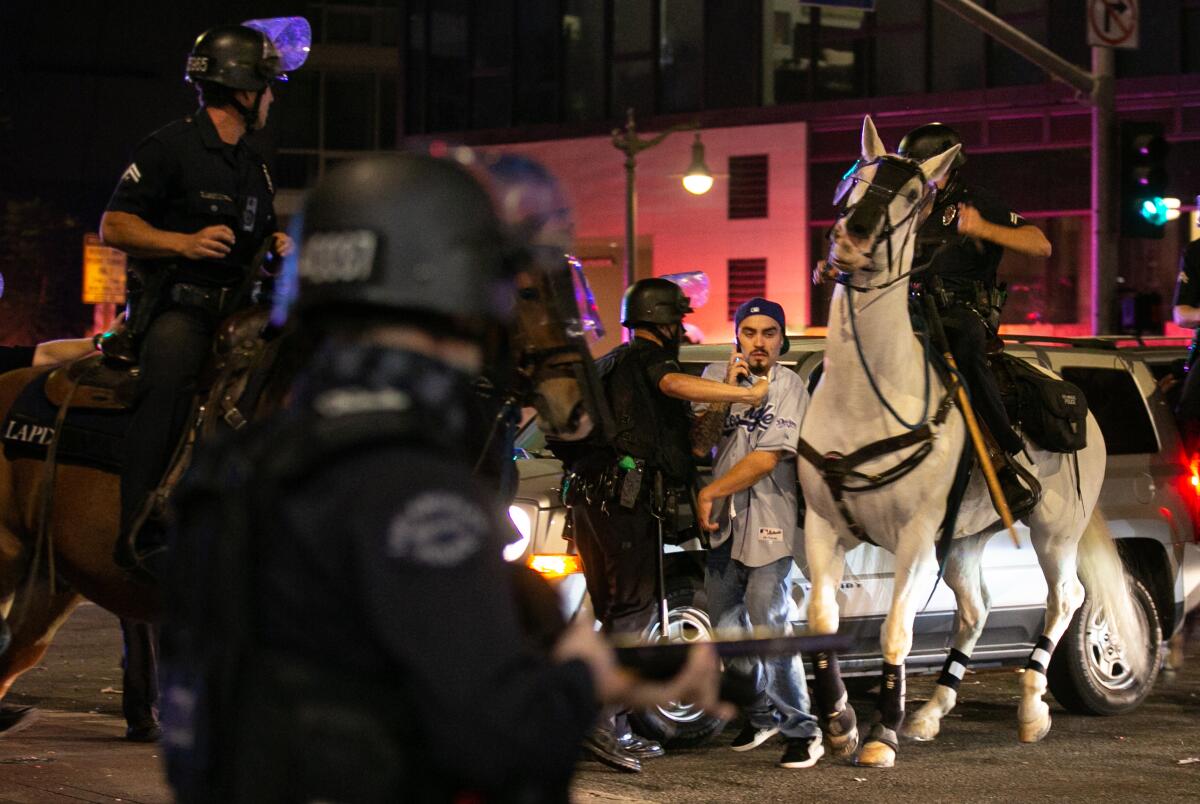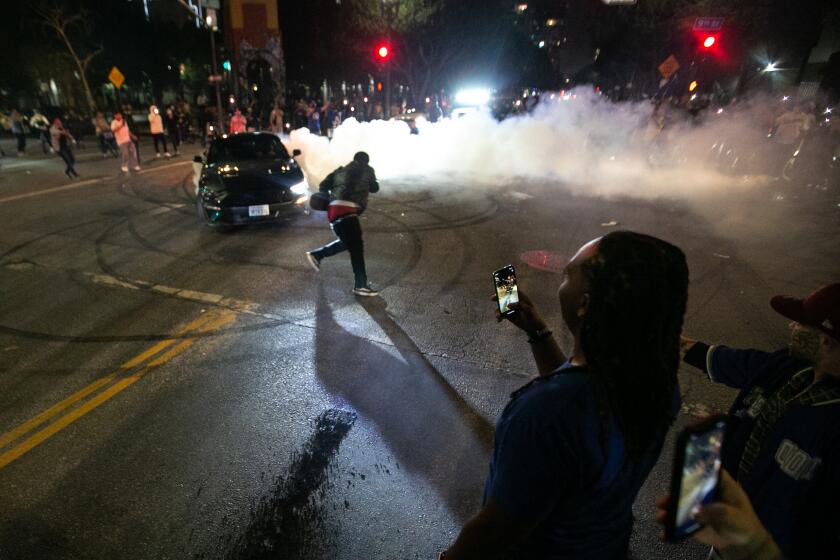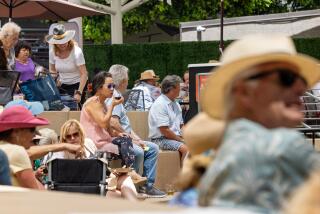Coronavirus spike in L.A. County brings new alarms

- Share via
There were new alarming signs that COVID-19 was spreading again in Los Angeles County, with officials announcing the highest one-day increase in cases not connected to a reporting backlog since August.
The county reported 1,745 new cases Thursday as well as 19 new deaths. It’s the latest evidence that after declining for several months, the novel coronavirus may be on the rise again in L.A. County and other parts of Southern California.
If the region does see another spike like the one it experienced during the summer, it would threaten efforts to reopen schools and businesses. Already, Southern California has fallen behind the Bay Area when it comes to slowing the infection rate, allowing places such as San Francisco and Silicon Valley to reopen more quickly.
Crowds gathered across the city to celebrate, mostly peacefully. But in downtown L.A. and Echo Park, the situation got tense.
“The high numbers of daily cases are very concerning because, as we have seen in the past, increases in cases lead to increases in hospitalizations and deaths,” L.A. County Public Health Director Barbara Ferrer said in a statement. “These increases impede our ability to move forward with reopening additional sectors and getting more children back to school.”
Officials have expressed concerns that COVID-19 is spreading from social gatherings tied to championship victories by the Lakers and Dodgers. There are also concerns about more potential infections with Halloween and Thanksgiving celebrations.
Crowds gathered across the city to celebrate, mostly peacefully. But in downtown L.A. and Echo Park, the situation got tense.
Los Angeles Mayor Eric Garcetti urged anyone who gathered to celebrate the teams’ championships to get tested for COVID-19.
“For those who went to the streets to celebrate … and were around strangers in an unsafe environment, please get tested and stay isolated for 14 days per the county’s Department of Public Health advice,” he said Wednesday.
Thousands took to the streets Tuesday after the Dodgers won the World Series — despite pleadings from health officials to stay home.
Officials had urged Dodgers fans to avoid crowds and practice social distancing while cheering on the hometown team and when celebrating their win. L.A. County health authorities have blamed gatherings related to the Lakers’ and Dodgers’ championship season for spreading the virus and preventing the county from reopening more quickly.
In four Southern California counties — Imperial, San Bernardino, Riverside and Los Angeles — the average number of new daily infections per 100,000 residents over the past week ranked among the top five statewide, according to The Times’ coronavirus tracker.
Compared to the previous week, new cases in Los Angeles County jumped from an average of 63.4 for every 100,000 residents to 111.3. The average case rate climbed from 77.5 to 140.3 in San Bernardino and from 94.4 to 111.5 in Riverside, while in Imperial new cases soared from an average of 141.5 per 100,000 residents to 225.8.
“We are seeing increased disease in the community,” Riverside County Public Health Director Kim Saruwatari told the county Board of Supervisors this week. “This is consistent with what other areas of the country are seeing, and we are fortunate that we’re not seeing it to the level that many others are.”
The coronavirus has devastated the local economy, with businesses begging to reopen. A rapidly reopening of the California economy this summer led to major spikes in cases, hospitalizations and deaths. The state instituted more restrictive rules and the cases fell this fall.
There is widespread hope that a vaccine could bring major changes. But experts said that will take time.
It may be 2022 before a coronavirus-weary world begins to feel a greater sense of normality, says the nation’s top infectious disease expert, Dr. Anthony Fauci.
If the U.S. can get a substantial proportion of residents vaccinated by about mid-2021, “I think it will be easily by the end of 2021 — and perhaps even into the next year — before we start having some semblance of normality,” Fauci said in candid comments during an online discussion hosted by an Australian university this week.
As a result, it may not be possible to achieve some longed-for hallmarks of normalcy without risking a super-spreading event, one in which a large number of people are infected, Fauci told the University of Melbourne.
Restaurants may not be able to return to full capacity, and professional sports venues may not be able to allow spectators until late 2021 or early 2022, he said.
Fauci said he could envision people, in masks, returning to theaters at a reduced capacity in mid-2021. But returning to maximum capacity in theaters without requiring masks probably won’t occur until “well over a year” from now.
Our sense of what’s normal may also change, Fauci said. He said he believed wearing masks would continue to be common, as it has been in many parts of Asia for decades preceding this COVID-19 pandemic.
A number of experts, including Fauci, are increasingly talking about the need for some type of mask mandate that’s national in scope.
Dr. Scott Gottlieb, who served as the head of the Food and Drug Administration under the Trump administration until 2019, says it’s time for a “limited and temporary national mask mandate,” as he wrote in an op-ed for the Wall Street Journal. Fauci has told CNN that “if people are not wearing masks, then maybe we should be mandating it.”
Apart from a vaccine, Fauci said in his talk with the University of Melbourne, what will be really important in dealing with the coronavirus in the long run will be developing antiviral drugs that can be used to treat those who test positive for the virus.
He said development of antiviral drugs that allow doctors to “only have to treat [patients] literally for a few days” could “take away the fear and dread of this particular disease.”
There are still some unknowns about the effects of COVID-19.
Scientists still don’t know, Fauci said, how durable immunity is among people who have survived an infection, and whether people can be reinfected by this coronavirus repeatedly, as can occur with common cold viruses.
If people lose immunity fairly quickly after recovering from a coronavirus infection, “we’re going to have a very difficult time over the next few years.”
More to Read
Sign up for Essential California
The most important California stories and recommendations in your inbox every morning.
You may occasionally receive promotional content from the Los Angeles Times.














